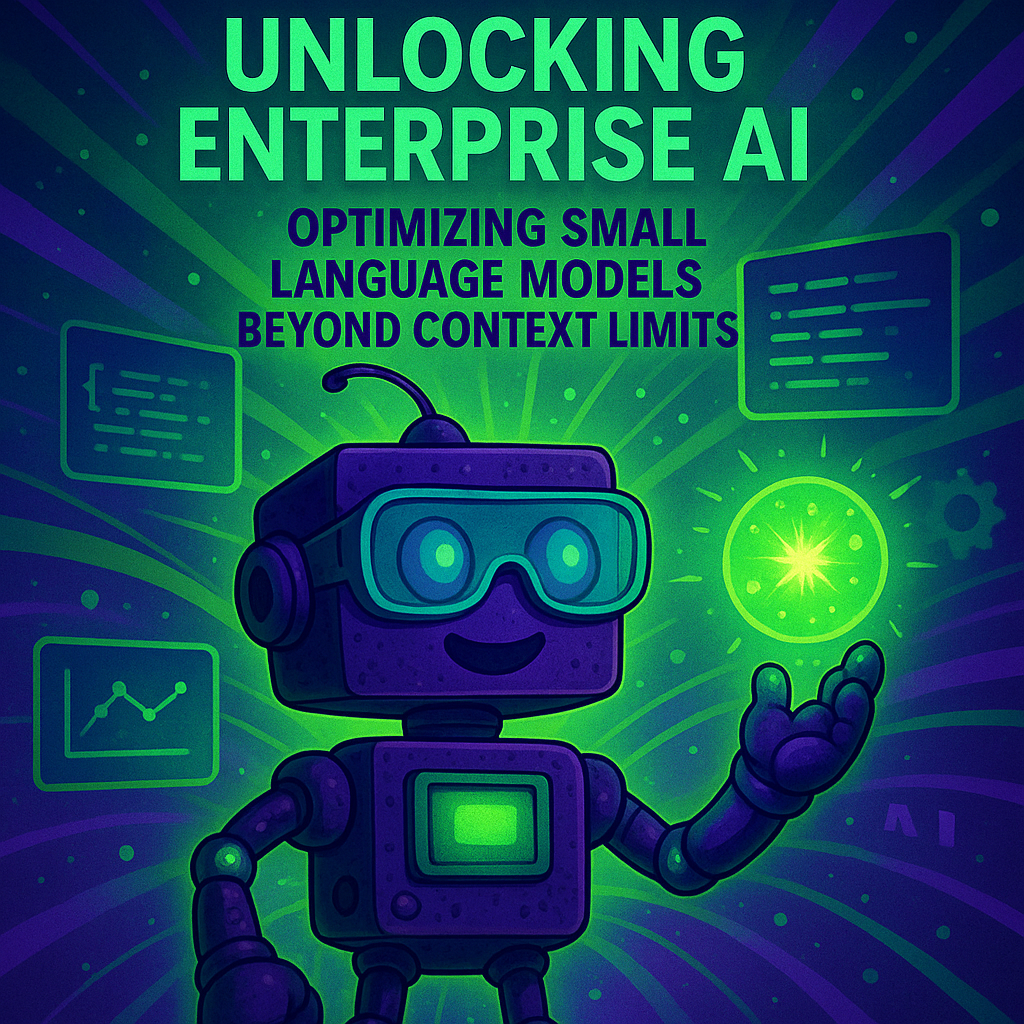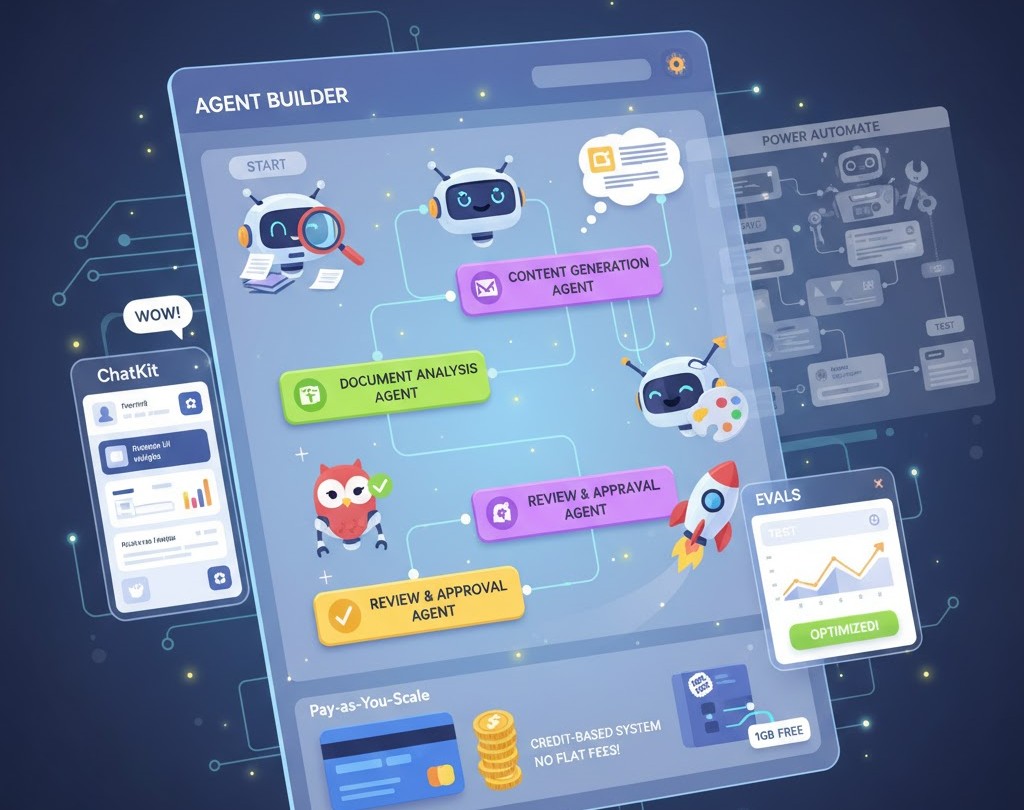Unlocking Enterprise AI: Optimizing Small Language Models Beyond Context Limits

Unlocking Next-Gen Automation: Why Small Language Models (SLMs) Are Your Strategic Advantage
The landscape of artificial intelligence is rapidly evolving, and Small Language Models (SLMs) like Microsoft's Phi series are emerging as a transformative force, particularly for automation companies and platforms like flowdevs.io. These compact yet powerful models are redefining what's possible, offering unparalleled efficiency, customization, and reliability for enterprise-grade automation solutions.
The Power of Precision: Why SLMs are a Game-Changer for Automation
Traditional large language models (LLMs) often come with hefty computational demands and opaque training data. SLMs, however, address these challenges head-on:
- Cost-Efficiency and Edge Deployment: Phi models, with parameters including Phi-4 at 14 billion active parameters and Phi-5 at 3.8 billion parameters (and an upcoming Flash version, which is a state space model), are designed to run efficiently on less powerful hardware, including CPUs and Qualcomm chipsets. This significantly reduces infrastructure costs and enables on-device processing, opening doors for automation at the edge – from smart TVs to industrial control systems. For
flowdevs.io, this means more accessible and scalable automation deployments. - Tailored Intelligence with LoRA: Customizing AI for specific business processes is crucial. Low-Rank Adaptation (LoRA) allows for lightweight fine-tuning of SLMs. Instead of retraining the entire model, LoRA modifies small, specific modules, drastically cutting down on computational cost and time. This enables
flowdevs.ioto rapidly adapt Phi models for unique automation tasks, ensuring precision and relevance. - Enhanced Reasoning for Complex Workflows: Despite their size, Phi models demonstrate remarkable reasoning capabilities, excelling in areas like math and coding. These foundational skills translate directly into robust planning and problem-solving, making them ideal for building sophisticated automation agents that can navigate complex, multi-step processes.
- Trust and Transparency: A key concern for enterprise adoption of AI is data provenance. Microsoft's Phi models are trained with strict guidelines, utilizing licensed and synthetically generated data that can be traced. Synthetic data generation involves using larger LLMs to transform existing licensed data (a "seed") into new formats, such as converting mathematical proofs into student questions and answers, rather than relying on the LLM's inherent training data. This transparency builds trust, making SLMs a reliable choice for sensitive automation tasks in sectors like healthcare and finance.
Mastering Context and Building Intelligent Agents
For flowdevs.io and other automation companies, managing context and building intelligent agents are paramount:
- "Unlimited" Context for Long Processes: While SLMs have defined context windows (e.g., 32,000 tokens, with 128,000 K on the horizon and models capable of extrapolating beyond tested limits), techniques like summarization and a "sliding window" approach allow for virtually unlimited context. By summarizing previous interactions and feeding them back into the model, automation workflows can maintain coherence over extended conversations or complex sequences, crucial for long-running processes. This approach also helps reduce the chances of hallucination by providing fresh context to the model, preventing it from becoming confused by excessively long context lengths.
- Agentic AI and Tool Use: SLMs are increasingly capable of acting as intelligent agents, leveraging external tools. Benchmarks like TailBench and Berkeley Function Calling (BFCL) are used to evaluate their tool-use capabilities. It's important to note that the current release of the Phi-4 model does not have web use tools baked into its training, so fine-tuning is encouraged to align them for such specific tool use. For
flowdevs.io, this means building automation agents that can interact with various systems and APIs, executing tasks with greater autonomy. - Model Distillation for Optimization: Model distillation is a powerful technique where a smaller "student" model learns from a larger "teacher" model. This process allows SLMs to inherit advanced capabilities from their larger counterparts, optimizing performance for specific automation tasks without the overhead of a full-sized model.
Real-World Impact and the Future of Automation
The adoption of Phi models is already widespread, from Japanese Airlines using them on handheld devices for cabin crew to healthcare for note summarization and general productivity, and even in smart TVs and industrial applications. Talent agencies are also using SLMs for summarization, note-taking, suggestions, and creative content, valuing the ability to track all training data and provide guarantees. Khan Academy leverages Phi for its math tutor and assistant, and industrial models in the Azure catalog are built on Phi for specialized tasks. Additionally, TELUS (a major Canadian telecommunications company) and Nike are among the diverse customers adopting Phi models, alongside widespread adoption in the open-source community and research labs.
As flowdevs.io continues to innovate in the automation space, leveraging the power, efficiency, and adaptability of Small Language Models like Phi will be key to delivering next-generation solutions that are not only cost-effective but also intelligent, reliable, and highly customized to meet the evolving demands of modern enterprises. The future of automation is small, smart, and incredibly powerful.
Unlocking Next-Gen Automation: Why Small Language Models (SLMs) Are Your Strategic Advantage
The landscape of artificial intelligence is rapidly evolving, and Small Language Models (SLMs) like Microsoft's Phi series are emerging as a transformative force, particularly for automation companies and platforms like flowdevs.io. These compact yet powerful models are redefining what's possible, offering unparalleled efficiency, customization, and reliability for enterprise-grade automation solutions.
The Power of Precision: Why SLMs are a Game-Changer for Automation
Traditional large language models (LLMs) often come with hefty computational demands and opaque training data. SLMs, however, address these challenges head-on:
- Cost-Efficiency and Edge Deployment: Phi models, with parameters including Phi-4 at 14 billion active parameters and Phi-5 at 3.8 billion parameters (and an upcoming Flash version, which is a state space model), are designed to run efficiently on less powerful hardware, including CPUs and Qualcomm chipsets. This significantly reduces infrastructure costs and enables on-device processing, opening doors for automation at the edge – from smart TVs to industrial control systems. For
flowdevs.io, this means more accessible and scalable automation deployments. - Tailored Intelligence with LoRA: Customizing AI for specific business processes is crucial. Low-Rank Adaptation (LoRA) allows for lightweight fine-tuning of SLMs. Instead of retraining the entire model, LoRA modifies small, specific modules, drastically cutting down on computational cost and time. This enables
flowdevs.ioto rapidly adapt Phi models for unique automation tasks, ensuring precision and relevance. - Enhanced Reasoning for Complex Workflows: Despite their size, Phi models demonstrate remarkable reasoning capabilities, excelling in areas like math and coding. These foundational skills translate directly into robust planning and problem-solving, making them ideal for building sophisticated automation agents that can navigate complex, multi-step processes.
- Trust and Transparency: A key concern for enterprise adoption of AI is data provenance. Microsoft's Phi models are trained with strict guidelines, utilizing licensed and synthetically generated data that can be traced. Synthetic data generation involves using larger LLMs to transform existing licensed data (a "seed") into new formats, such as converting mathematical proofs into student questions and answers, rather than relying on the LLM's inherent training data. This transparency builds trust, making SLMs a reliable choice for sensitive automation tasks in sectors like healthcare and finance.
Mastering Context and Building Intelligent Agents
For flowdevs.io and other automation companies, managing context and building intelligent agents are paramount:
- "Unlimited" Context for Long Processes: While SLMs have defined context windows (e.g., 32,000 tokens, with 128,000 K on the horizon and models capable of extrapolating beyond tested limits), techniques like summarization and a "sliding window" approach allow for virtually unlimited context. By summarizing previous interactions and feeding them back into the model, automation workflows can maintain coherence over extended conversations or complex sequences, crucial for long-running processes. This approach also helps reduce the chances of hallucination by providing fresh context to the model, preventing it from becoming confused by excessively long context lengths.
- Agentic AI and Tool Use: SLMs are increasingly capable of acting as intelligent agents, leveraging external tools. Benchmarks like TailBench and Berkeley Function Calling (BFCL) are used to evaluate their tool-use capabilities. It's important to note that the current release of the Phi-4 model does not have web use tools baked into its training, so fine-tuning is encouraged to align them for such specific tool use. For
flowdevs.io, this means building automation agents that can interact with various systems and APIs, executing tasks with greater autonomy. - Model Distillation for Optimization: Model distillation is a powerful technique where a smaller "student" model learns from a larger "teacher" model. This process allows SLMs to inherit advanced capabilities from their larger counterparts, optimizing performance for specific automation tasks without the overhead of a full-sized model.
Real-World Impact and the Future of Automation
The adoption of Phi models is already widespread, from Japanese Airlines using them on handheld devices for cabin crew to healthcare for note summarization and general productivity, and even in smart TVs and industrial applications. Talent agencies are also using SLMs for summarization, note-taking, suggestions, and creative content, valuing the ability to track all training data and provide guarantees. Khan Academy leverages Phi for its math tutor and assistant, and industrial models in the Azure catalog are built on Phi for specialized tasks. Additionally, TELUS (a major Canadian telecommunications company) and Nike are among the diverse customers adopting Phi models, alongside widespread adoption in the open-source community and research labs.
As flowdevs.io continues to innovate in the automation space, leveraging the power, efficiency, and adaptability of Small Language Models like Phi will be key to delivering next-generation solutions that are not only cost-effective but also intelligent, reliable, and highly customized to meet the evolving demands of modern enterprises. The future of automation is small, smart, and incredibly powerful.
Related Blog Posts

October 2025 Wild AI Meetup Recap: The Future of AI-Driven Automation: Strategic Insights for Modern Businesses

OpenAI's New Agent Builder: A Game-Changer for Enterprise Automation


.jpg)